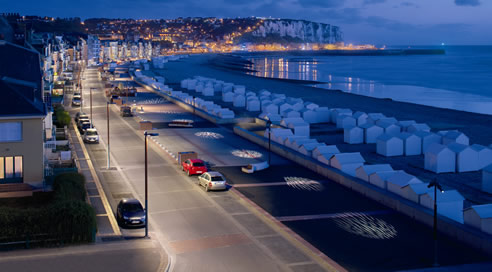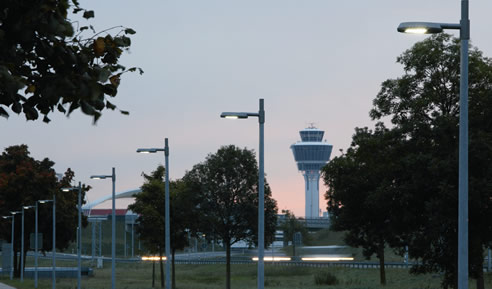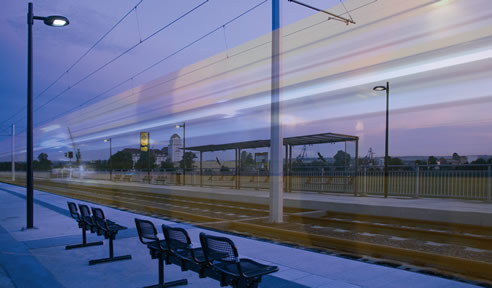Knowledge and Ability in LED Luminaires from WE-EF Lighting Knowledge and ability in LED luminaires. Both the production and the application of LED luminaires require know-how and experience. High efficiency and long service life - the general advantages offered by LED technology - are well-known to those who work with light and lighting. However, where substantial planning decisions need to be made, the transition to modern solid-state lighting is still considered risky by some investors. Each project has its own unique requirements; although LEDs are not always the best solution for all lighting tasks, the technology has reached a level that allows it to address the typical requirements for a high standard of street-lighting and architectural lighting. Evidence of this is provided by the number of successful projects. Manufacturers require special knowledge Luminaire manufacturers require interdisciplinary know-how to develop the benefits of LED technology for users as well as provide optimum electric, thermal and technical operating conditions for solid-state lighting sources. WE-EF, as a luminaire manufacturer, has in-depth experience in this regard. In 1999, the company implemented the first large LED project with the SONY Centre in Berlin. At the 2008 Light+Building fair, WE-EF introduced the OLC® One LED Concept technology and the RFL500 LED luminaire series for street and area lighting. WE-EF has continued to develop its diverse range of LED-based products, including: underwater lighting; inground uplights; recessed and surface-mounted luminaires for walls and ceilings; projectors; and street and area lighting luminaires. The luminaires provide proof of their technical qualities and design potential in numerous lighting applications around the globe. Impressive cost savings WE-EF has implemented its most extensive LED project to date with the city of Bielefeld. The city is now able to reduce its power consumption for public street lighting by 1.8 million kWh per year. The key to these soughtafter savings was the installation of 5,889 VFL540 LED street and area lighting luminaires. The VFL LED luminaire has a power input of only 21 W compared with 89 W of the original mushroom opal glass luminaires - an impressive saving in times of continuously rising cost pressures. Additional energy savings can be achieved by a 55 per cent reduction during evening hours (between 10:30 p.m. and 4:30 a.m.). At the same time, light quality has also improved noticeably. The LED luminaires illuminate the traffic areas much more evenly, and the former noticeable bright and dark zones have become a thing of the past. Targeted light and glare-free environment The technical quality of lighting was also a big concern for the street lighting planners of the Neue Burg residential area in Wolfsburg. Since this project also involved the placement of post mounted luminaires near buildings, it was important that disruptive light spillage would be avoided. With their precise lighting and effective anti-glare features, WE-EF LED luminaires can reliably meet these requirements. All footpaths and roadways at Neue Burg are illuminated by the RFL500 LED street and area lighting luminaire series, each with 24 LEDs and a connected rating of 59 W. Similar to all other WE-EF LED post mounted luminaires, their light distribution is based on CAD-optimised OLC® lenses made of PMMA. OLC® is an optical concept developed by WE-EF, which features multi-layer technology at its centre. In contrast to the typical multi-spot technique, the multi-layer approach ensures that each individual LED illuminates the entire target area. Each LED creates a layer of light that is identical in all aspects. The sum of these layers represents the required performance. The result is a homogeneous light distribution with a high level of visual comfort. Another advantage is that the loss or reduction of luminous flux in individual LEDs does not reduce the degree of uniformity; the average illumination will just decrease accordingly. Key competence - LED lenses In order to supply tailored illumination for different lighting classes and road requirements, WE-EF offers it's LED street and area lighting in many different wattages, and with various light distributions. The development of high-quality and efficient LED lenses is one of WE-EF's key competencies. This range includes the [S60], [S65] and [S70] lenses for street lighting distribution as well as the [A60] asymmetric 'forward throw' distribution and the [R65] with rectangular 'forward throw' distribution. The efficiency of the luminaire is increased by another optical component developed by WE-EF. With RFC® Reflection Free Contour technology, the conventional flat glass cover is replaced by a UV-stabilised acrylic cover, the contoured surface of which follows the shape of the 'butterfly' lens. This reduces the amount of internal reflection (within the luminaire) and increases the overall efficiency by approximately 5 per cent. It is possible to achieve a 20 per cent to 30 per cent increase in spacing between luminaires compared with lenses made of flat glass. Due to their excellent glare control, the technology developed by WE-EF not only satisfies street lighting standards, but can be applied to public spaces where visual comfort is a priority. One such example is the tram system in Dresden. Dresdener Verkehrsbetriebe, the city's public transportation authority, has set out to illuminate its 38 new city tram stops with WE-EF LED luminaires. This project has already been successfully implemented with RFL530 LED street and area lighting luminaires at four stations. With a connected rating of only 31 W, the LED luminaires require only half as much energy as conventional solutions consisting of high-pressure sodium lamps of 63 W. The transportation operators were convinced of the light quality of the RFL luminaire after a one-year test installation period. Tailored switching and dimming capabilities In contrast to conventional discharge lamps, LEDs supply a measurable luminous flux immediately after activation. Moreover, LEDs can be easily controlled to suit the demand of situations resulting from traffic, time of day or weather conditions. With its Eco Step Dim® light management system, which is available in four variants - Motion, Basic, Advanced and Dynamic - WE-EF supplies all the components that are required to implement the various control options. There are solutions for both small- and large-scale lighting systems in which luminaires can be controlled and dimmed from a central location, based on time or ambient lighting. Parameters for monitoring and maintenance can be easily recorded and analysed. The systems can be extended, which allows operators to start with simple solutions and expand them to include complex urban networks. The switching and dimming capabilities of LEDs are already being utilised at the La Chaux-de-Fonds market place in the Swiss canton of Neuchatel, where 20 RFL540 LED luminaires have been installed in the central market square. The post mounted luminaires installed at the square's centre are equipped with twin controllers that are switched separately. Therefore, power consumption and luminous flux can be reduced by 50 per cent during less frequented periods at night or days on which the square is not being used. Even in 'save mode', the square appears evenly lit and without disruptive shadow zones. Needs-appropriate switching therefore provides additional savings to the already low connection load offered by this LED solution. The new system is capable of saving up to 60 per cent of current net energy costs with an LED service life of at least 50,000 hours.  Sustainable thinking goes beyond saving energy The efficient use of energy was also an important motivation for the project managers of Swindon Triangle, a residential area in Swindon, the United Kingdom, when they were considering street-lighting using LED luminaires. However, the sustainable approach pursued by the planners in the redevelopment of this 1930s settlement goes far beyond simple energy savings. Low-energy houses made of organic building materials, the use of rainwater, photovoltaic facilities, an infrastructure accessible entirely by foot or bike, car pooling and even a separate kitchen garden are just some of the measures that make living in this residential area as environmentally friendly as possible. Naturally, this requirement was also extended to the selection of luminaires for the streets of Swindon Triangle. The planners decided on RFL530 street and area lighting luminaires. With a connected rating of only 28 watts, they illuminate the streets and pathways of the project with minimal energy requirements, and also impress with their ecological balance sheet over the entire life cycle. The luminaire body of the RFL530 is made from a marine-grade low copper content aluminium alloy - an alloy that can be recycled with only 5 per cent of originally used energy. Overall, more than 90 per cent of the material quantities that are used can be recycled for the luminaires. Moreover, the modular structure of the luminaires also ensures sustainability. For example, once the LEDs reach the end of their service life or are upgraded, the LED modules are simply replaced. WE-EF is currently working on an analysis of the ecological footprint of its LED streetlighting luminaires - an analysis that is unusually comprehensive for the industry. With partners such as PE International, a specialist for life cycle assessments, and IBU (Institut Bauen und Umwelt), the company is evaluating the effects of the production, installation, operation and recycling of its luminaires on the environment. The full evaluation will be completed with an Environmental Product Declaration (EPD) pursuant to ISO 14025. The environmental declaration provides verifiable and comparative information about the environmental burdens created by a product. Investors and operators who emphasise the sustainability of their projects are increasingly requesting such EPDs. Combining light sources The extensive WE-EF LED programme features a modular design and a variety of colour temperatures that can be used to create striking lighting effects for exterior spaces in combination with other light technologies. One example is a project that links LEDs and metal halide lamps in an integrated solution. This has been done at the beach promenade in the French city of Mers les Bains. RFL540 LED street and area lighting luminaires illuminate the roadways with a soft white 3000 K light that provides a pleasant atmosphere. The appealing architecture of the beachfront houses is highlighted with ETC140 inground uplights that are equipped with neutral-white 4000 K metal halide lamps. FLC240 projectors with integrated gobos create an oval motif of a wave pattern on the ground, thereby providing a literally seamless transition to the beach area.
|
03 8587 0400 6/13 Downard Street, Braeside, Vic, 3195
|


 Modern Catenary Solution Fit for
Modern Catenary Solution Fit for WE-EF's New Managing Director for
WE-EF's New Managing Director for A New Era for WE-EF LIGHTING – A Home
A New Era for WE-EF LIGHTING – A Home Myers Park Lighting Upgrade:
Myers Park Lighting Upgrade: Bridging the Past and Future: Old Murray
Bridging the Past and Future: Old Murray WE-EF Profile Projectors for Sharper
WE-EF Profile Projectors for Sharper Award-winning Bay Pavilions, Arts +
Award-winning Bay Pavilions, Arts + Enhancing Transit Experience at Byron
Enhancing Transit Experience at Byron Intelligently Illuminating the Bay Run
Intelligently Illuminating the Bay Run WE-EF Lighting's Role in Protecting
WE-EF Lighting's Role in Protecting Sustainable LED Upgrade Kit from WE-EF
Sustainable LED Upgrade Kit from WE-EF A Natural Paradise Rottnest Island by
A Natural Paradise Rottnest Island by WE-EF LIGHTING's Braeside Expansion
WE-EF LIGHTING's Braeside Expansion Street and Area Pole-Mounted Luminaires
Street and Area Pole-Mounted Luminaires Smart Lighting Control Technology from
Smart Lighting Control Technology from High-Output Floodlights with Modern LED
High-Output Floodlights with Modern LED Bondi Beach Pavilion Reimagined by WE-EF
Bondi Beach Pavilion Reimagined by WE-EF Balancing Needs: Sea Turtle Conservation
Balancing Needs: Sea Turtle Conservation Architecturally Pleasing Recessed
Architecturally Pleasing Recessed Luminaires for Lake Macquarie Multi-Arts
Luminaires for Lake Macquarie Multi-Arts
